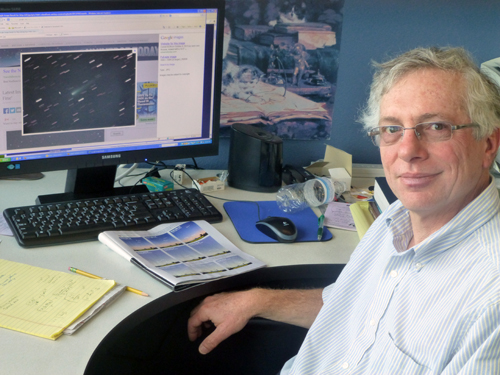
By Donald H. Harrison

EL CAJON, California – As if Thanksgiving and the first day of Chanukah falling on the same day were not coincidence enough, the comet ISON will be at its closest point to the sun—about 750,000 miles away– on that day, Thursday, Nov. 28th.
Grossmont College Astronomy Prof. Ross Cohen says for people who don’t have the proper equipment for comet watching, at the time of its closest approach to the sun, it is safest to turn to the Internet or to television to view images from satellites that will be tracking the comet from various vantage points in space.
At its closest point to the sun, called the perihelion, Comet ISON skims past the sun– as viewed from Earth. But various satellites have other vantage points and might even see it cross in front of the sun.
If Comet ISON survives the transit, it is expected to display a bright trail of rock, ice and other space materials gathered from its origin in the mammoth Oort Cloud, a vast expanse of comets surrounding our solar system. Cohen suggests that pre-dawn in the first several days of December may be the safest time to see the comet because viewers won’t have to contend with the sun’s glare.
Comet ISON is named for the International Scientific Optical Network, under whose auspices two Russian scientists — Vitali Nevski and Artyom Novichonok—spotted the comet at a distance of 6 A U on September 21, 2012. An A U is the distance between the Earth and the Sun, approximately 93 million miles.
In that it was visible by telescope more than a year before it would reach perihelion prompted a lot of speculation among astronomers that the Comet ISON might be among the brightest ever observed, Cohen said. But further analysis of its narrow elliptical orbit helped pinpoint its origin to the Oort Cloud, which is up to 50,000 times farther from the Sun than is the Earth.
In that ISON comes from the Oort Cloud, rather than from the closer Kuiper Belt, it can be reasoned that it has been traveling hundreds of thousands of years in its first trip to our solar system since some unknown event occurred to knock it out of its previous orbit. “It either had a collision with some other Oort Cloud object or possibly the gravity of a passing star could have perturbed its orbit and sent it on one heading for the sun,” Cohen said.
Unlike comets that have gone around the sun before and have survived the trip, Comet ISON faces a more uncertain future as it approaches and reaches perihelion, Cohen said. “It could disintegrate and when it comes around we could see nothing, or the ice could be greatly energized by the sun. All comets leave some sort of trail of dust and water vapor and the more this material spreads out, the more extravagant that is going to be – unless it gets too hot, and then it would go bust.”
Cohen says the convergence of the American Thanksgiving holiday, the Jewish Chanukah holiday, and ISON perihelion is a remarkable triple coincidence—but that is all it is, a coincidence.
Thanksgiving is celebrated on a solar calendar. Chanukah is celebrated on a lunar calendar, to which a full month is added in certain years to stay synchronized with the solar calendar. Comets can travel for hundreds of thousands, or even millions of years, he said.
*
Harrison is editor of San Diego Jewish World. He may be contacted at donald.harrison@sdjewishworld.com